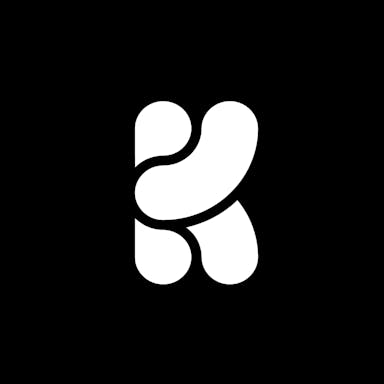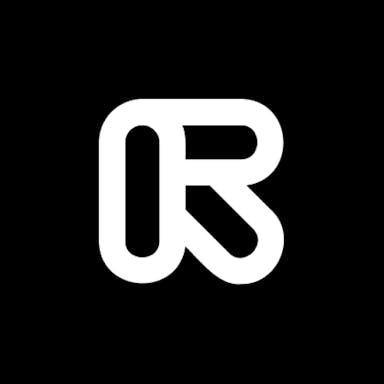Thesis
Generative AI is reshaping how digital content is created and consumed. Since the launch of OpenAI’s GPT-4o image generation feature in March 2025, user adoption has soared: over 130 million people generated more than 700 million images in the first week alone. As of March 2025, 71% of images shared on social media were AI-generated or AI-edited. On the video side, 51% of marketers used AI tools for video creation or editing as of February 2025.
This surge in AI-generated content adoption is driven by converging supply and demand forces. On the demand side, consumers are consuming more video content than ever: US adults are dedicating an increasing share of their digital media consumption to video, from a daily average of three hours in 2021 to three hours and 50 minutes in 2024, indicating an 8.5% CAGR.
This increasing appetite for visual content is creating a growing demand for fresh, engaging material. On the supply side, this demand is being met by an expanding creator economy: there were over 207 million content creators worldwide as of 2025, with 162 million creators based in the US. Meanwhile, 86% of US marketers plan to partner with influencers in 2025, further amplifying the need for scalable content production. This creates a perfect storm where both individual creators and brands need tools to produce more visual content, which is exactly what AI generation enables.
At the same time, breakthroughs in model architecture are unlocking new creative capabilities. Latent consistency models (LCMs) and techniques like Flux have reduced image generation latency from minutes to seconds, while foundation models such as Sora (OpenAI), Veo (Google), and Gen-3/4 (Runway) are enabling real-time, high-fidelity video generation with controllable motion and style. Industry analysts expect this pace of model innovation to continue on a six-12 month cycle, further accelerating the adoption of AI-powered creative workflows.
Krea is uniquely positioned to capitalize on the convergence of rising content demand, expanding creator supply, and advancing AI capabilities. Rather than building foundational models from scratch, Krea aggregates leading creative AI models and provides a browser-based interface that allows users to generate, train, and edit images and videos across models in real time. By abstracting away technical complexity and unifying fragmented creative workflows, Krea provides an orchestration layer which is intended to allow users to leverage the latest generative AI capabilities without the friction of code or prompt engineering. In a fragmented ecosystem of model providers and text-based commands, Krea is betting that the user experience layer (not the model layer) will determine long-term adoption and retention in creative AI.
Founding Story
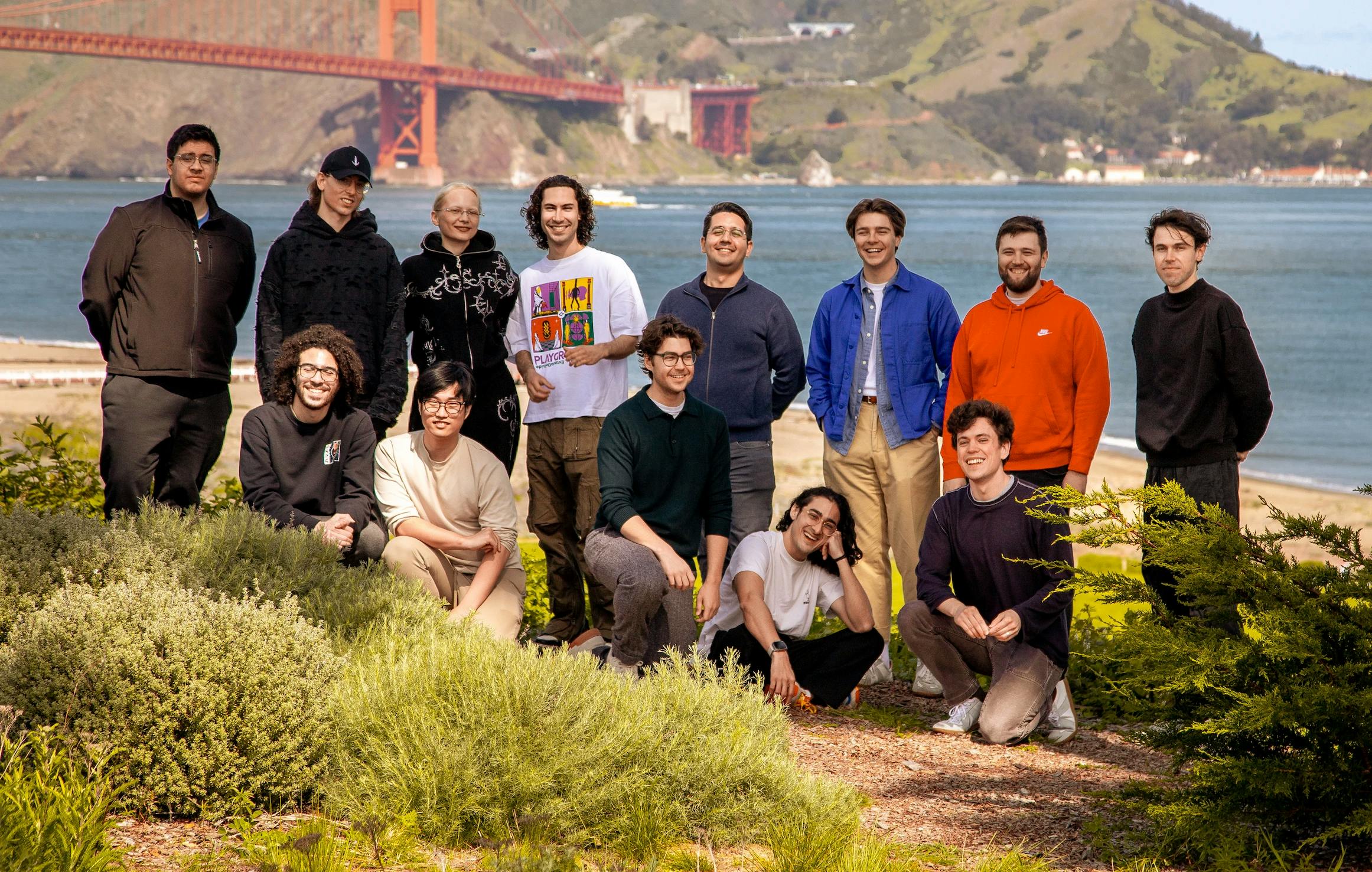
Source: Krea AI
Krea was founded in 2022 by Victor Perez (CEO) and Diego Rodriguez (CTO), two longtime friends and creative technologists. The pair first met as undergraduate students in Barcelona in the early 2010s while pursuing degrees in audiovisual systems engineering. Both of them consider themselves creators. Rodriguez introduced Perez to coding and generative adversarial networks for AI image generation, sparking Perez’s interest in AI.
After graduation, both founders pursued AI research and were awarded full scholarships by the King of Spain to attend Cornell University. While Rodriguez began graduate studies in New York, Perez started working on generative models. Perez felt that coding was limiting the creative capabilities he had, and Python was not the best interface to use this tech creatively. The idea for Krea emerged from this frustration with existing creative tools. Perez began building interfaces to communicate with AI for artistic purposes, sharing his progress with Rodriguez through constant exchanges about AI and creative tooling. Rodriguez applied with Perez’s idea to HF0 — a residency program for technical founders, and got an offer. The two then decided to start Krea, and Rodriguez put his graduate studies on pause.
A breakthrough for the nascent company came when Simian released its Latent Consistency Model; using this, Perez hacked together a live demo at a dinner party that transformed real-time camera input into stylized visuals. That demo became the foundation of Krea’s real-time AI canvas. The tool quickly gained traction when they posted AI spirals, one of the company’s viral mini-apps, on Twitter. The company raised it’s first round of funding, a pre-seed, in June 2022.
Product
Krea is an AI-powered creative suite that enables creators and enterprises to generate, enhance, and remix images, videos, and 3D content in real time. Designed for accessibility and speed, Krea’s browser-based platform combines intuitive controls with advanced AI models.
Using Krea AI
Web Interface
Krea provides a simple browser-based user interface requiring no installation or technical setup. Krea AI operates by allowing users to train AI (using text, image, videos, etc) on their distinctive styles, subsequently generating visuals (images, videos, 3D models). Users can select from a group of tools to start creations.
The creation process is fairly straightforward. To generate or to train a model on a given style, users can drag a few images and click “train.” In a few minutes, the style will be ready to use in Krea’s generator. Krea also provides an “Assets” folder for organizing generated content, and features such as upscaling, enhancement, and scene transfer are integrated into the workflow. For more complex projects, users can manage multiple creations within a large, flexible workspace.
Functions and Use Cases
Krea provides multiple AI creation functions, including image generation, image enhancement, image animation, video generation, video restyling, 3D object generation, 3D scene generation, style training, design inspiration, real-time editing, and more.

Source: Krea
The interface includes intuitive controls for adjusting style, prompt strength, resemblance, image and video aspect ratios, and video resolutions. Krea provides artistic styles through pre-built styles, communities, and allows users to train their own styles. Users can upload reference images, select from a library of prebuilt or custom-trained styles, and fine-tune outputs using sliders and toggles.

Source: Krea
Besides creation, Krea provides a gallery for users to view other people’s work, share their work, and potentially collaborate. Some users share their prompts and styles to allow people to regenerate the same work.
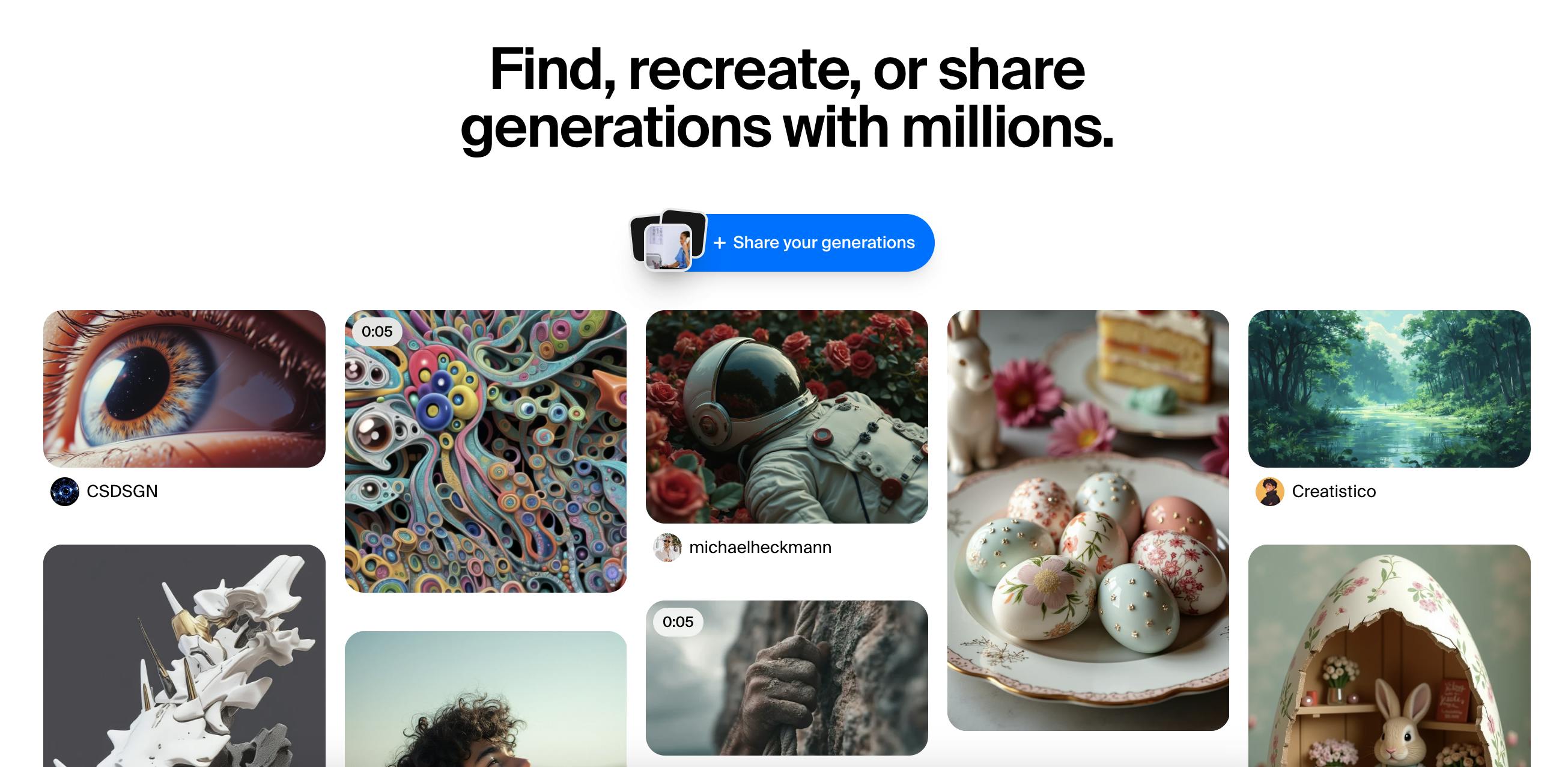
Source: Krea
Model Versions and Capabilities
Krea aggregates many creative AI models, comparable to Perplexity except for AI creators’ tools. These include Flux, Wan2.1, Veo 2, Kling, Hailuo, and more, with support for new models added constantly. As of April 2025, Krea used Flux as the default model for Image and real-time generation, Wan 2.1 for video generation, and Hunyuan3D-2 for 3D generation.
Based on an unverified online source, Krea utilizes advanced Latent Consistency Models (LCMs), a cutting-edge evolution of Stable Diffusion technology, to achieve rapid image generation speeds. Unlike traditional diffusion models that require 50 or more iterative steps, LCMs streamline the process to just two to four steps, enabling Krea to produce high-quality images in as little as 0.8 seconds.
Based on a Reddit comment by Krea co-founder Rodriguez’s, Krea’s real-time image generation speed is achieved by a mix of (1) using many GPUs, (2) optimization techniques of and around the model, and (3) the infrastructure was built to scale to millions of users.
Key Functions
Image Generation and Real-time Editing

Source: Krea
Krea’s Image offering helps users to generate images with customized styles in Flux and ideogram. It enables users to generate images from text or image prompts, transform existing images, customize styles (choose from premade styles or train your own to match specific aesthetics), add details and improve resolution, and enhance real or generated images through Enhancer.
Meanwhile, Krea’s real-time editing tool provides real-time AI image generation capabilities and a novel user interface in a real-time AI rendering on a canvas. Users can interact with the AI through a split-screen interface: on one side, users can draw, sketch, or manipulate shapes and layouts; on the other, the AI-generated output updates instantly in response to these changes and to text prompts. This immediate feedback loop allows creators to make immediate adjustments to their designs, such as inserting shapes or changing object positions, which are then reflected in the AI-generated image in real-time.
Video and Video Restyle
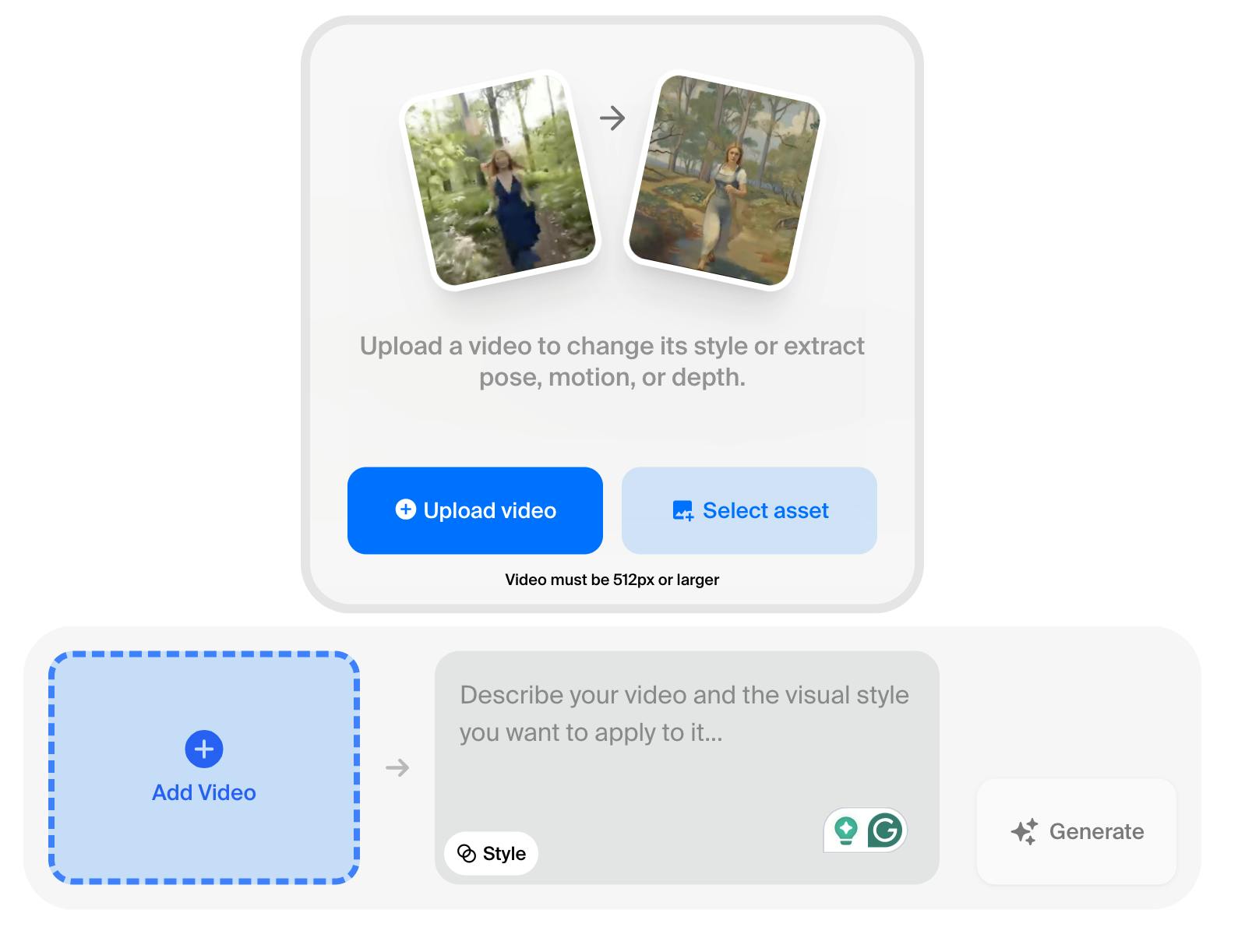
Source: Krea
Krea supports text-to-video, image-to-video, and video restyling by integrating top models. Users can animate images, change video style, and maintain character consistency across frames. Krea presents the user with the option to use both “key frame” still images and text prompts in the same project. Video upscaling and enhancement tools further refine outputs for professional use.
3D Objects and Stage

Source: Krea
With Krea’s 3D tools, users can convert 2D images into 3D models and assemble them into interactive scenes, adjusting object position and lighting in real time. Krea’s 3D tool converts user-uploaded images, photos, or generated assets into 3D models and uses them in real-time tools. Users can experiment with angles, textures, and lighting for more engaging visuals. Its Stage tool lets users generate editable 3D environments and get consistent snapshots of them.
Custom AI Model Training
Krea enables users to train personalized AI models by uploading a small set of images. Paid users can keep models private for brand or client work. Training types include style, person, and object, each requiring a different approach and number of images. Users can train AI models based on personal photos or commercial projects, with the latter benefiting from a diverse image library to enhance product backgrounds.
Market
Customer
Krea AI primarily targets individual creators (both professional and amateur) who use the platform to produce visual assets such as illustrations, concept art, short-form videos, and branded content. As of April 2025, Krea reported having over 20 million users on its platform. The company is also gaining traction among organizational users and creative teams within enterprises. Customers listed in press and public materials include Perplexity, Loop Earplugs, Pixar, LEGO, and Samsung, suggesting usage across tech, media, and consumer brands. These customers reflect an early footprint in both B2C and B2B applications. Krea is expected to launch an enterprise-focused product later in 2025, with compliance credentials including SOC 2 Type II and ISO 27001 — an important step for adoption in regulated or security-conscious industries.
Market Size
Krea operates across both the AI image generation and AI video generation markets.
AI Image Generation
The AI image generation market was valued at approximately $299.2 million in 2023. The market size for AI image editors, specifically, was estimated at $80.3 million in 2024. On average, an estimated 34 million new AI-generated images were created daily as of 2024, indicating substantial adoption. According to surveys from 2024, over 50% of artists wereusing AI tools to create art, and 58% of respondents said that they were already using AI in photo editing as of 2024, mostly because it saves a significant amount of time. For example, Adobe Firefly produced 1 billion AI-generated images by July 2023. Midjourney generated 964 million AI images, with 17.5 million Discord members as of December 2023.
AI Video Generation
The AI-generated video market is projected to grow at a 35% annual rate, reaching approximately $14.8 billion by 2030. According to one unverified estimate, AI-generated videos accounted for 40% of video content on major social media platforms as of March 2025. Companies are integrating these tools to support automated video ad creation, internal training content, and user-generated campaigns. 70% of marketing teams are projected to integrate AI-generated videos into their content strategies by 2029.
Competition
As Krea provides AI image, video, and 3D model generations for creators and enterprises, it competes with AI image, video, and 3D design software suites and toolkits. This market is competitive, with both established incumbents such as Adobe, Google, OpenAI, etc., and startups such as Midjourney, Pika Labs, Runway, Luma AI, Kling AI, and Hailuo AI. Krea seeks to differentiate itself by prioritizing real-time, accessible, and creator-centric workflows to lower technical barriers and deliver professional-grade outputs. However, it faces increasing pressure from both specialized startups and large-scale, multi-modal platforms as the market accelerates.
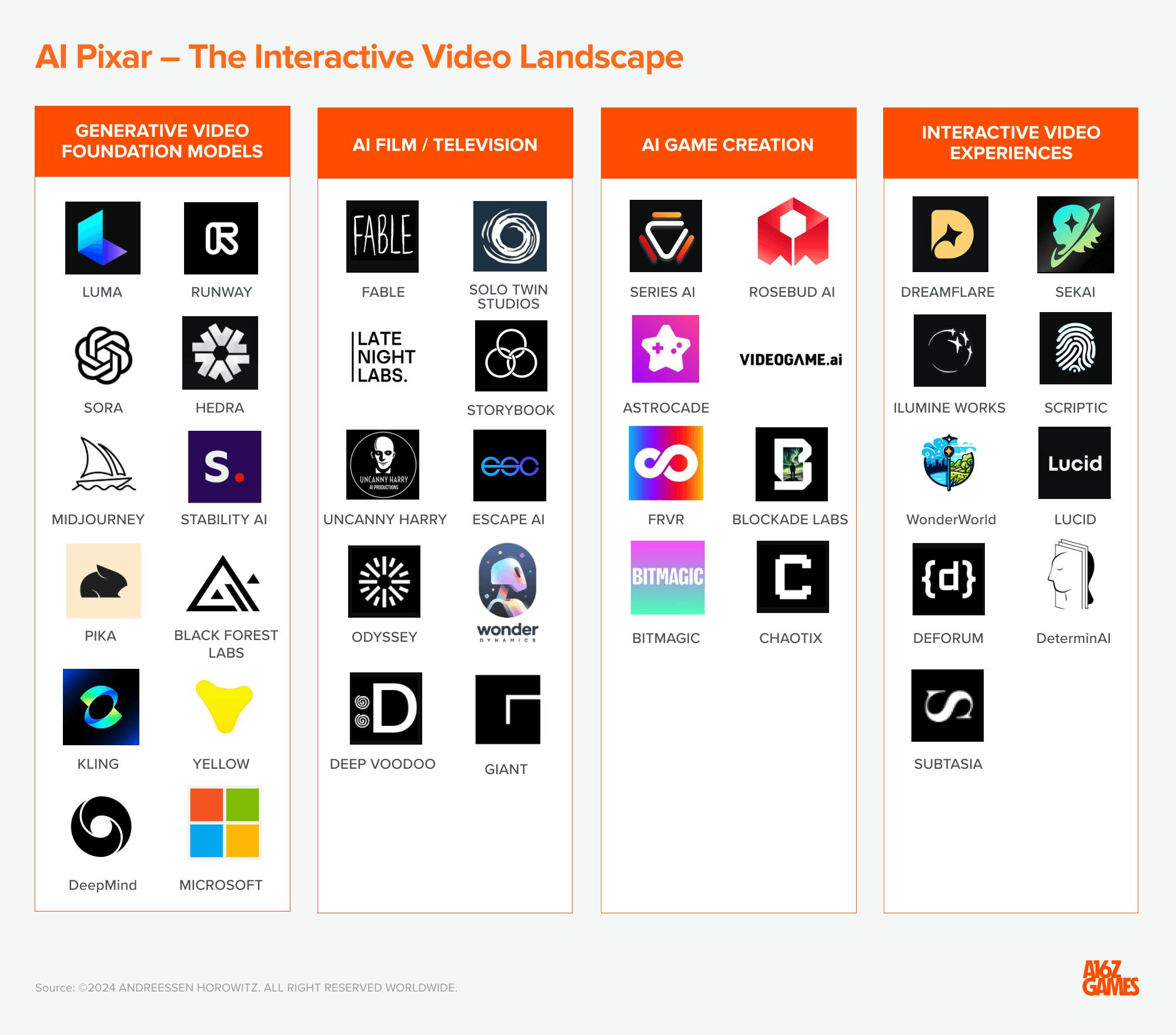
Source: a16z
AI Image and Video Creation Platforms
Midjourney: Midjourney was founded in 2021. It focuses on high-fidelity artistic image generation through diffusion models and operates primarily through Discord, offering batch-based generation that emphasizes aesthetic quality over speed or fine control. Bootstrapped, no public funding disclosed. As of June 2025, Midjourney has not raised any external funding and appears committed to remaining independent. Midjourney offers tiered subscription models, ranging from $10/month to $120/month. Midjourney’s pricing is on the higher side in the market. Midjourney’s Discord server surpassed 21 million members in 2025. It recorded over 13 million visits in April 2025 alone on the web. As of October 2023, Midjourney’s customers were likely to fall into two buckets based on use case: advertisers and artists. It competes with Krea in image generation for individuals and small creative teams.
Adobe Firefly: Firefly was launched in 2023 by Adobe. Firefly integrates AI generation into Creative Cloud apps like Photoshop and Illustrator. It offers commercial-grade image generation with strong editing, style control, and compliance with brand safety standards. In February 2025, Adobe announced the video model in Firefly. Adobe targets professional graphic designers needing high-precision creative control within traditional software ecosystems. Firefly offers tiered plans, ranging from $10/month to $60/month. It has the advantage of driving adoption among existing Adobe users.
Stability AI: Stability AI was founded in 2019, and it provides community-driven open-source diffusion models for customizable image, video, audio, and 3D generation. Tools like ComfyUI and Fooocus support advanced workflows. Stability AI raised $101 million at a $1 billion valuation in October 2022, led by Coatue, Lightspeed Venture Partners, and O’Shaughnessy Ventures. It has raised a total of $256 million in funding as of June 2025. Stability AI competes in providing open-source and free tools for creators.
3D/Video-First Generative AI Tools
Pika Labs: Pika Labs, founded in 2023, offers text-to-video, image-to-video, and video-to-video generation. It also provides a selection of lightweight AI video editing tools. Pika has reported "millions of users," including use cases from Thirty Seconds to Mars for concert visuals. Pika has raised a total of $135 million as of June 2025, including an $80 million Series B in June 2024 that valued the company at $470 million. Key investors include Spark Capital, Lightspeed Venture Partners, Greycroft, and individual investors like Jared Leto and Quora founder Adam D'Angelo. Pika offers subscription plans that range from free to $60/month.
Runway: Runway was founded in 2018. It is a web-based generative video platform designed to democratize professional video production. Runway offers a suite of AI tools such as Gen-2 and Gen-3 for real-time video-to-video transformations, text-to-video generation, green screen editing, and more. In April 2025, Runway had raised $308 million in a new funding round, led by private equity firm General Atlantic. With this round, it had raised a total of $591 million and was valued at over $3 billion. Similar to Krea, Runway also provides real-time collaboration throughout the full design process. It focuses on professional and enterprise use. Runway offers pricing plans that range from free to $76/month (unlimited). On the enterprise side, Runway inked a deal with Lionsgate in September 2024 to augment the film and TV studio with Runway AI tools.
Luma AI: Luma AI, founded in 2021, specializes in photorealistic 3D modeling and video generation. Its Ray 2 model (Dream Machine) provides text-to-video, image-to-video, and video-to-video generation, emphasizing natural, coherent motion and realism. Luma’s strength lies in creating realistic 3D scenes and cinematic-quality video shots, appealing to creators focused on precision and photorealistic outputs. As of June 2025, Luma has raised a total of $173 million from investors including Andreessen Horowitz, Matrix, and Amazon. Luma AI offers plans that range from free to $95/month (unlimited).
Large AI Labs and Multi-Modal Generative Platforms
OpenAI: OpenAI was founded in 2015. It provides advanced image and video generation models, including DALL·E for text-to-image generation, GPT-4o's new Image Generation capabilities for real-time multimodal interaction, and Sora, its high-fidelity text-to-video model. Sora targets longer-form video creation with strong narrative and cinematic quality. OpenAI is becoming a critical competitor as it integrates multi-modal generation into productivity and creative workflows at scale. These models are available for ChatGPT subscribers with certain access levels. OpenAI has raised a total of $61.9 billion in funding as of June 2025, and was valued at $300 billion as of March 2025.
Google DeepMind: Google DeepMind was founded in 2010. Google has released models and tools for image and video generation, including Imagen for text-to-image generation, Veo for text-to-video, with plans for integration into YouTube and Google Cloud. In May 2025, Google announced Flow, a new AI-powered video tool geared toward filmmaking. Flow allows users to import characters or scenes or create those artifacts within the tool. It also offers features like camera control, scene builder, and tools for asset management. Besides, Google is launching “Flow TV,” a curated stream of clips and content where others can see exact prompts behind these videos to understand other users’ creative flows. These image and video generation models will be included in Google’s AI pricing plans, ranging from free to $249.99/month.
Business Model
Krea provides individual subscription models and enterprise plans.
The individual subscription model follows freemium pricing plans. Krea offers four different levels of plans for personal use, ranging from free to $80 per month ($64 per month for yearly subscriptions). The usage is calculated by compute units, which are a measure of computational resources used to generate images or videos. Different tasks consume varying amounts of compute units based on their complexity and output quality. For example, generating a high-resolution image or a longer video will use more compute units than a smaller image or a shorter video.
Krea does not accumulate or carry over compute units between billing cycles. At the start of each month, each user’s compute unit balance is reset to your plan's allocated amount, regardless of any unused units from the previous month. This ensures a fresh start and consistent resource availability for all users each month.
Krea also offers additional compute packs (similar to what mobile cellular data) for users with a subscription, allowing users to generate more than their subscription allows without needing to upgrade their plan.

Source: Krea
Krea for Teams is Krea’s enterprise plan. Krea provides a free team collaboration setup and enterprise plan pricing based on team sizes and advanced features.
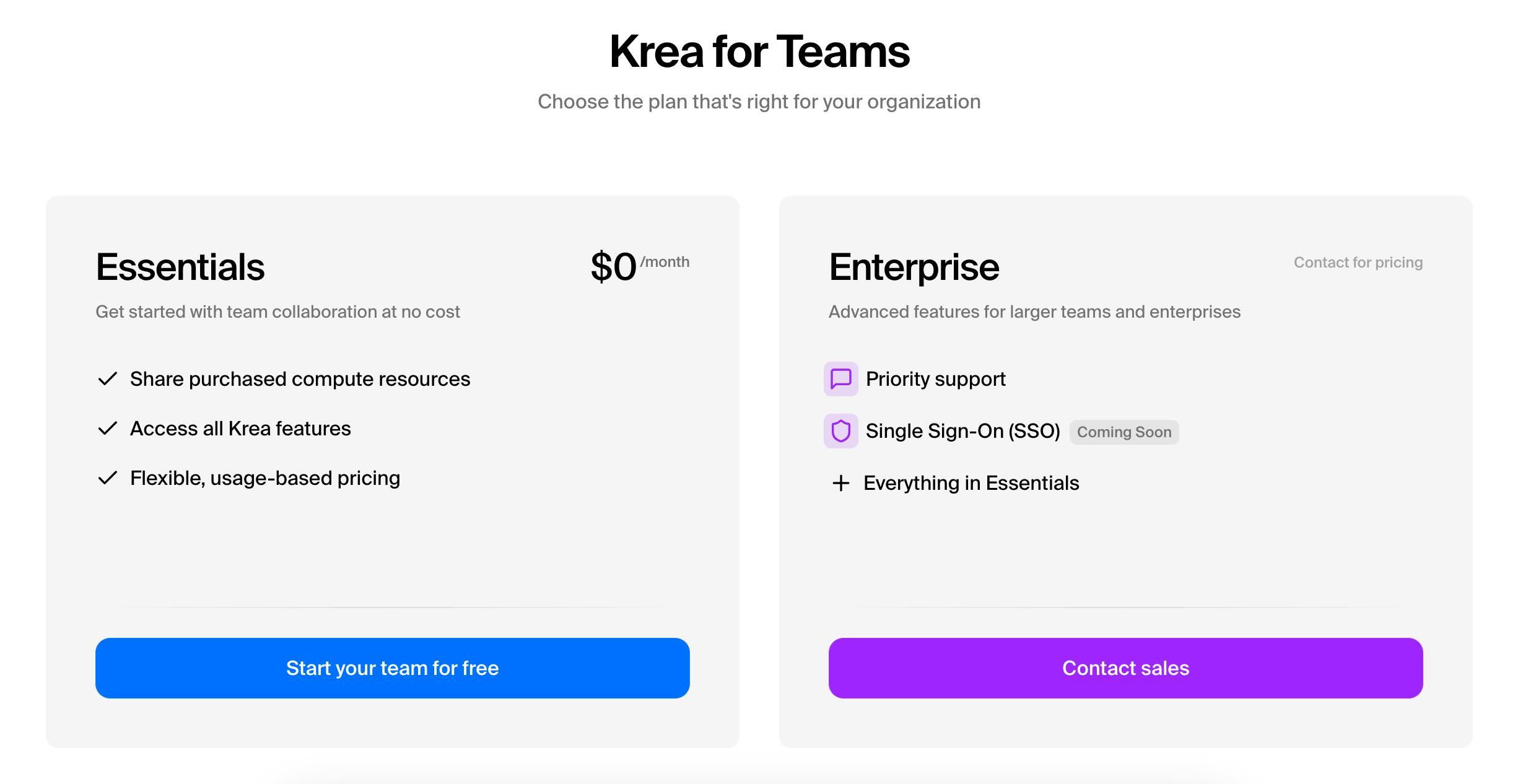
Source: Krea
Traction
As of April 2025, Krea had grown to over 22 million users. The company’s ARR reached $8 million as of April 2025, representing a 20x increase in 14 months. Krea’s user base spans creators and enterprises globally, with notable customers including Perplexity, Loop Earplugs, Pixar, LEGO, and Samsung.
As of April 2025, Krea had rolled out more than 50 major product updates since launch. In March 2024, Krea was recognized by Fast Company as one of the “Most Innovative Companies” in AI-powered media creation. The company’s growth and impact are further underscored by its ability to scale with a lean team. Krea had eight employees when they started in March 2022, and expanded to 17 employees, including talent from leading universities and the authors of state-of-the-art AI models as of April 2025.
Valuation
Krea has raised a total of $83 million across four funding rounds as of June 2025. It raised a $47 million Series B in April 2025 led by Bain Capital Ventures. Krea’s post-money valuation following this round was approximately $500 million.
Prior to that, Krea raised a $33 million Series A in June 2023, led by Andreessen Horowitz. Its $3 million seed round, announced in early 2023, was led by Pebblebed, a fund founded by Keith Adams (cofounder of Meta AI) and Pamela Vagata (founding team at OpenAI). Other early investors include HF0 (the AI residency that incubated Krea), A*, Abstract Ventures, and Gradient Ventures, Google’s AI-focused fund.
Key Opportunities
Growing Demand for Visual Content
YouTube, Instagram, and TikTok have become important marketing tools due to their massive global audiences, high engagement rates, and advanced features like targeted advertising, influencer partnerships, and integrated shopping, which enable brands to effectively reach, engage, and convert consumers. The ability to interact directly with consumers, combined with analytics tools that measure campaign effectiveness, has made social media a powerful alternative to traditional advertising channels.
With the shift in marketing, visual content has become the dominant format online. In 2024, visual content received 94% more views than text-only content, and posts with images on social media platforms saw 150% more engagement compared to those without visuals. Video accounted for approximately 82% of all consumer internet traffic by 2022 — a figure 15 times higher than in 2017. By 2025, 89% of businesses are expected to use video as a marketing tool, with short-form videos delivering the highest ROI across all marketing trends. 82% of all online content is expected to be video by the end of 2025, with short-form video leading the charge. This surge in demand for visual content means creative teams must now deliver more dynamic, personalized, and visually engaging content at faster speeds than ever before.
Krea is positioned to capitalize on this trend by offering real-time AI-powered image and video generation. Its platform enables creators to rapidly produce animated assets, branded visuals, and design enhancements without the need for dedicated motion designers. Krea’s SaaS and usage-based pricing models lower the cost barriers for agile content teams, making high-frequency, scalable content production accessible to a broader customer base. This positions Krea as a key enabler for creators and marketers navigating the demands of the evolving social media landscape.
Disrupting Animation Production Workflows
The animation industry, across both 2D and 3D formats, continues to follow a structured workflow comprising pre-production, production, and post-production. Despite advancements in tools such as Autodesk Maya, Blender, and Toon Boom Harmony, substantial portions of the work — storyboarding, keyframe animation, rigging, and compositing — still rely heavily on manual effort. This traditional, labor-intensive process contributes to high production costs and long timelines, especially for small and mid-sized studios under increasing pressure to deliver faster.
Krea has the opportunity to disrupt these workflows by embedding AI into critical stages of the animation pipeline. In pre-production, Krea’s image generation and style training tools can automate storyboarding, character design, and concept exploration from simple sketches or prompts. During production, AI-driven interpolation and scene layout tools can streamline the creation of in-between frames and complex animations. In post-production, Krea’s 3D and video generation tools can assist with background enhancement, transitions, and style consistency, reducing reliance on manual visual effects work. By accelerating production and lowering costs, Krea can make high-quality animation more accessible to a wider range of creators and studios.
Building a "Creative OS" for Studios and Small Teams
The expansion of the creator economy is driving increased demand for accessible, cost-effective creative tools among independent creators, indie game studios, educators, and freelancers. Traditional creative suites like Adobe Creative Cloud and Autodesk Maya are often prohibitively expensive and complex, leaving a gap for lightweight, AI-powered solutions tailored to the needs of small teams.
Krea is well-positioned to address this gap by unifying fragmented creative workflows into a single, intuitive platform — a “Creative OS” for the next generation of creators. Its browser-based interface enables real-time animation, scene design, and visual enhancement, while collaborative tools and asset management features streamline project development for distributed teams. Krea’s ability to aggregate leading AI models, provide instant iteration, and support custom model training empowers users to achieve professional-quality results without the overhead of legacy software.
Early adoption by indie studios and small teams demonstrates its value in real-world production environments. As these users build workflows around Krea, the platform can drive network effects, deepen user loyalty, and become the foundational creative workspace for independent creators and small teams worldwide.
Key Risks
Rapid Evolution of AI Models
While Krea currently benefits from leveraging state-of-the-art Flux models based on Latent Consistency Models (LCMs), the generative AI landscape is evolving rapidly. Innovation cycles for diffusion-based and real-time generation models are shortening, with new architectures emerging approximately every 6–12 months. Competitors in open-source (Stable Diffusion by Hugging Face and Stability AI) and private research labs (Google DeepMind Imagen, Open AI Sora, and 4o Image Generation) are actively developing faster, more controllable, and more efficient models
Adobe has recently integrated multiple third-party AI models, including Flux 1.1 Pro, into its Firefly app, expanding its AI capabilities. This move indicates a trend where platforms are diversifying their AI model integrations to stay competitive. Stability AI introduced Stable Point Aware 3D (SPAR3D), a real-time editing and complete structure generation of a 3D object from a single image in less than a second, and Stable Virtual Camera, a multi-view diffusion model that transforms 2D images into immersive 3D videos with realistic depth and perspective. Some other players are also developing in this space.
For Krea, there is a risk that newer models could offer superior speed, controllability, or quality, eroding Krea’s lead. To sustain its differentiation, Krea will need to maintain a continuous innovation pipeline, invest in model fine-tuning and UI optimization, and possibly build proprietary model extensions. The risk is not immediate, but staying ahead of technological shifts will be critical to avoid the commoditization of real-time generation.
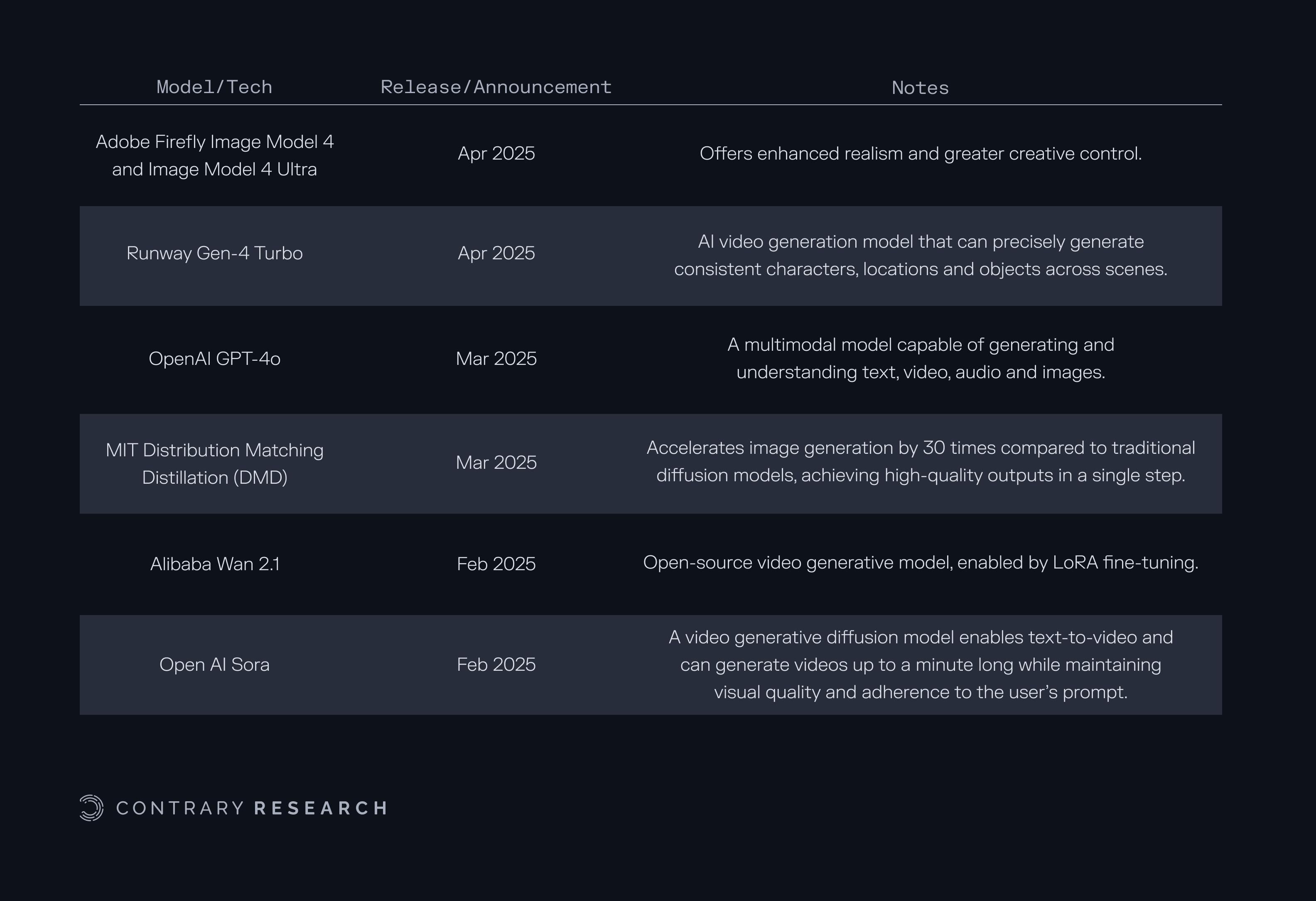
Source: Fabian Mosele, Contrary Research
Open-Source, Low-Cost, and General Competitions
Open-source models and tools such as Stable Diffusion, ComfyUI, and Fooocus are rapidly improving and can be freely customized. Some of these tools are ready-to-use for creators, and new players can use such models to develop new tools in this space for creators. For indie creators and small teams, pricing would be a significant consideration point when they choose tools, they may prefer free tools over paying for Krea’s SaaS model.
Many lightweight content creators use multiple tools interchangeably; a 2024 survey from MBO Partners shows that over 73% of creators use more than three tools for different parts of their content creation workflow (e.g., Canva + CapCut + Midjourney + Photoshop). Without strong ecosystem lock-in (collaboration features, asset libraries, integrations), Krea risks users treating it as an occasional tool rather than a core platform. For example, Canva built stickiness by offering brand kits, collaboration workspaces, and team asset libraries — not just individual design tools. Thus, Krea might face pricing pressure and user churn if it cannot deliver sufficient additional value (e.g., better UX, integrated workflows).
Legal and Intellectual Property (IP) Risks
AI-generated images and animations raise questions about copyright ownership, licensing, and ethical sourcing of training data. Companies like Stability AI and Midjourney have faced lawsuits over alleged use of copyrighted material for model training. Potential legal challenges or regulatory restrictions could slow AI image and video generation platforms like Krea ’s adoption, especially among enterprise and professional users.
Summary
Krea aims to be a next-generation creative copilot for artists, designers, and marketers, combining real-time image and video generation with intuitive, high-control workflows. It competes in a rapidly expanding generative AI market, powered by strong tailwinds such as the creator economy growth and short-form video market expansion.
Unlike traditional creative software or newer AI labs optimizing for long-form or cinematic content, Krea emphasizes real-time feedback, intuitive sketch-to-image workflows, and lightweight video generation. However, Krea faces significant competitive pressure from both open-source ecosystems like Stable Diffusion and well-funded tech giants expanding aggressively into image and video generation. Success will depend on Krea’s ability to continuously innovate on model speed and control, expand its product ecosystem, and lock in a loyal creator user base. If successful, Krea could pioneer the next generation of AI-powered creative tools and reshape how visual content is produced across industries.
